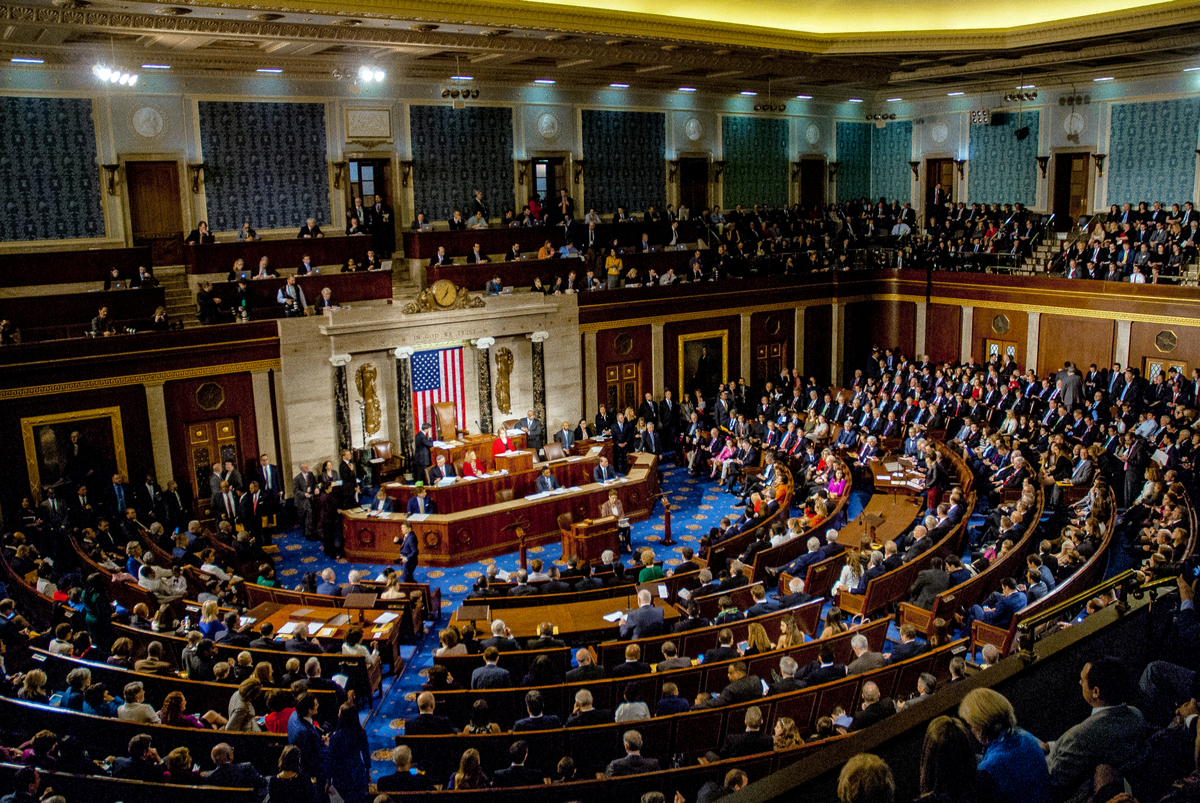 The introduction of three bills in the 114th Congress gives an inside look and feel of the EB-5 atmosphere within the House and the Senate. Representative Zoe Lofgren, Ranking Member of the House Judiciary Committee, Subcommittee on Immigration and Border Security, and Representative Luis Gutiérrez introduced H.R. 3370, the Entrepreneurial Business Creating Jobs Act of 2015. This is the third bill introduced in the 114th Congress that focuses on reauthorizing the EB-5 program.
The introduction of three bills in the 114th Congress gives an inside look and feel of the EB-5 atmosphere within the House and the Senate. Representative Zoe Lofgren, Ranking Member of the House Judiciary Committee, Subcommittee on Immigration and Border Security, and Representative Luis Gutiérrez introduced H.R. 3370, the Entrepreneurial Business Creating Jobs Act of 2015. This is the third bill introduced in the 114th Congress that focuses on reauthorizing the EB-5 program.
In January 2015, Representatives Mark Amodei (R-NV) and Jared Polis (D-CO), introduced H.R. 616, the American Entrepreneurship and Investment Act. In June 2015, The American Job Creation and Investment Promotion Reform Act, S. 1501, was introduced in the Senate by Senate Judiciary Committee Chairman Charles Grassley (R- IA) and Senate Judiciary Committee Ranking Member Patrick Leahy (D-VT). What differences and similarities are afforded by these three bills, and how does the latest bill, H.R. 3370, change the landscape and attitude towards the EB-5 program? A comparison of all three bills and their key proposals can be found below, and a more detailed comparison chart can be found here.
|
Key Proposal |
Senate Bill S. 1501 |
House Bill H.R. 616 |
House Bill H.R. 3370 |
|
Permanency? |
September 30, 2020 (5 years) |
Permanent |
Permanent |
|
TEA Designation |
5,000 visas set aside for TEA; valid for 2 years. Authority rests within DHS and not bound by Federal or State governmental or non-governmental entity. |
5,000 visas set aside; determined by State agency. DHS shall defer to State. Valid for 2 years. |
4,000 visas set aside for high unemployment areas; 2,000 for rural areas; and 2,000 for counties with a 20% or greater decrease in population since 1970, a state or federal economic development incentive program, or an area within the boundaries of a military installation closed under the BRAC law. TEA valid for 5 years. |
|
Preapproval of NCE |
Required, and will need the following for adjudication: 1) comprehensive business plan; 2) economic report; 3) SEC documents; 4) investment and offering documents, 5) including marketing materials; description of policies and procedures to confirm compliance with securities law; 6) certification that persons involved have complied with securities laws; 7) economic analysis for TEA/CSA. |
Optional preapproval process included in legislation. |
Optional preapproval process included in legislation. |
|
Effect of Preapproval |
Will be binding on subsequent petitions and afford deference unless there is evidence of “fraud, misrepresentation, criminal misuse, a threat to public safety or national security, a material change that affects the approved economic model, other evidence affecting program eligibility that was not disclosed during the approval process, or a material mistake of law or fact in the prior adjudication.” |
Deference given. |
Deference given: legislation requires that the “Secretary make final decisions on all issues . . . other than those issues unique to an individual investor in the new commercial enterprise.” Eliminates the need for repeated submission of project documents once preapproved. |
|
Securities Attestations |
Regional center (RC) needs to certify compliance and has policies and procedures in place and must annually reissue such certification. |
Not addressed in legislation. |
RC needs to certify that the RC, to the best knowledge of the applicant, and all parties to the RC, are in compliance with securities laws. RC will be responsible for monitoring and supervising all offers and sales of securities and maintaining the records. Annual certification. |
|
Annual Statement |
Each year, the RC must submit a statement certifying compliance, disclosing any litigation or bankruptcy, accounting of foreign investor money, evidence 100% of capital is committed, a detailed progress, accounting of direct jobs created/preserved, and description of all funds. Disclosure of whether there has been a material change. |
Not included. |
Annual statement submitted to USCIS including: description of litigation or bankruptcy proceedings; accounting of all foreign investor money into the RC and projects; accounting of capital invested for each project; description of how capital is deployed per business plan; evidence the capital is 100% committed to the project; evidence progress is made to completion of the project; accounting of all the jobs counted (direct and indirect); fees collected from investors other than for the investment, including a description, entities that received the fees, and the purpose for the fees; and a statement certifying the accuracy. |
|
Processing Times |
“On average”: 120 days for I-924, 150 days for I-526, and 180 days for I-829. Fees may be adjusted to achieve these processing timeframes. |
Adjudication within 180 days; if RFE, 30 days upon receipt of response |
Does not address or prescribe processing times. Preapproval process provided–see below. |
|
Numerical Limits |
Not addressed in legislation. |
Spouse and child eliminated from 10,000 numerical limitation, and eliminates per country quotas. |
If the visa numbers have been exhausted, an additional 10,000 may be made available for that fiscal year unless a joint resolution is enacted. |
|
Concurrent Filing of I-526 and AOS |
Allowed if there is a visa available. |
Allowed if there is a visa available |
Allowed if there is a visa available. |
|
Job Creation Methodology |
Revised methodology (repeals in part section 610 of Public Law 102-395); 90% can be indirect; 10% must be direct; can have credit of jobs from non-alien investors only for percentage of total jobs created that is equal to percentage of total investment, but cannot exceed 30%; no tenant occupancy allowed. Bureau of Economic Analysis (BEA) must accept methodology. |
No change to existing law. “Reasonable methodologies” for determining jobs created indirectly through revenues generated from increased exports, improved regional productivity, or increased domestic capital investment. |
Methodology to be approved by DHS and Commerce; job creation outside the geographic boundary of the RC may be considered if the estimated job creation is supported by substantial evidence and is no more than 50% of estimated jobs. |
The bill introduced by Representatives Amodei and Polis seeks to permanently authorize the EB-5 program and provides for much-needed reforms from the perspectives of the regional centers, investors, and the United States Citizenship and Immigration Services (USCIS). Some of the key provisions of the bill include eliminating derivatives from the 10,000 numerical limit for the EB-5 visa category so that the amount of total investment pouring into the country can be maximized, and keeping TEA designation authority to the state. The bill also proposes to shorten processing times for the adjudication process. In addition, H.R. 616 addresses security concerns by including provisions that will strengthen the integrity of the program and require regional centers to have accountability for their actions.
The Senate bill, S.1501, is a much more detailed bill that seeks to reform all aspects of the program. The provisions, if enacted, would change the job creation methodology, the entity that determines Targeted Employment Area designations, and the source of funds requirements for the investor. In addition, S.1501 focuses on a number of integrity measures that require strict compliance from the regional center, shifting almost all liability to them. These include an annual certified compliance statement, site visits, compliance with security measures, and background checks. Any violation could result in termination of the regional center, as determined by the unreviewable discretion of the Department of Homeland Security (DHS). Moreover, S.1501 includes various transparency provisions to ensure that undue influence is eliminated and that there is no preferential treatment given by USCIS. All of the measures proposed by S.1501, while conceptually are much needed, do not work practically in the EB-5 realm.
There is no doubt that the introduction of both H.R. 616 and S.1501 show the impact of the EB-5 program and just how important this job-creating, investment-yielding program is to the United States and its economic growth. Numbers alone show that between 2005 and 2013, the EB-5 program generated $5.2 billion dollars in foreign direct investment into the United States. It is true that there has been some negative media about the EB-5 program as of late, both regarding the DHS and regional centers, but the EB-5 program is a positive program that stimulates economic growth and allows projects and industries to grow, including the rebuilding of the Pennsylvania Turnpike, and the development of charter schools, the Hudson Yards in New York City, and hospitals, among countless other projects.
The bill introduced by Representatives Lofgren and Gutiérrez underscores just how important this program is to the United States. The bill is a nice hybrid and combination of H.R. 616 and S.1501 in that it focuses on the much-needed reforms for the program, while also ensuring that strengthening the integrity of the program is addressed. The bill seeks permanent reauthorization of the program and provides for allowing additional visa numbers if the 10,000 cap is reached. It also includes workable security and compliance measures for the regional center, along with a much more neutral platform of authority given to the DHS when faced with violations. The bill also establishes a process to ensure timely adjudication of all cases, and proposes a much more workable definition for designating TEAs.
The introduction of H.R. 3370 by two leading House Democrats shows the willingness of Representatives in the Democratic leadership to keep the program and to keep the conversation alive between the House and the Senate, and between Republicans and Democrats, leading to bipartisan support. Both Representatives are key leading supporters of immigration reform, and focusing on the EB-5 program in light of the program’s expiration indicates the urgency and importance of the keeping the EB-5 program intact. The bill has many key provisions that will be part of the discussion for reauthorization of the program by September 30, 2015.
DISCLAIMER: The views expressed in this article are solely the views of the author and do not necessarily represent the views of the publisher, its employees. or its affiliates. The information found on this website is intended to be general information; it is not legal or financial advice. Specific legal or financial advice can only be given by a licensed professional with full knowledge of all the facts and circumstances of your particular situation. You should seek consultation with legal, immigration, and financial experts prior to participating in the EB-5 program Posting a question on this website does not create an attorney-client relationship. All questions you post will be available to the public; do not include confidential information in your question.








